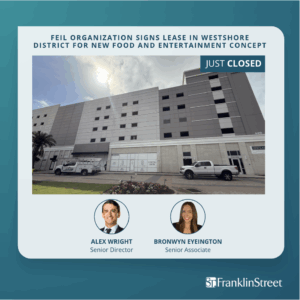As multifamily dominated the Jacksonville investment sales market in 2021, the Jax Daily Record asked Franklin Street’s Laura Gonzales, Regional Managing Director, what’s driving Northeast Florida’s apartment boom. Below is an excerpt of her response:
Jacksonville, the largest city in Florida, has experienced positive population changes, increases in wages, strong market fundamentals and has outperformed the U.S. in terms of employment growth.
Jacksonville is no longer a secret.
Many people are moving here and are targeting this market to purchase commercial real estate. This has resulted in increased demand for ownership of multifamily projects.
Over the past two years, Duval County increased its total population by about 24,000 residents. Nassau, St. Johns and Baker counties all increased their populations by 5.27%, 5.06% and 4.92%, respectively.
The migration to Florida primarily has been from New York, Georgia, Michigan, New Jersey and Illinois.
Jacksonville sustained higher employment percentage gains in Q3 and Q4 2020 and all of 2021. Jacksonville’s unemployment rate is about 3.5%, which is below Florida and the national unemployment of about 4.2%.
In 2021 Jacksonville saw the largest absorption with more than 1,300 units, and vacancy rates still declined quarter over quarter. We anticipate 2022 to absorb a minimum of 600 units, 2023 about 585 units and 2024 about 400 units.
Jacksonville saw a record increase in 2021 of 22% year over year of rent growth. This was a tremendous growth over 2020 of 4%, 2019 of 3% and 2018 of 4%.
We anticipate rental rates will continue to increase with 2022 at 25% growth, 2023 at 26% and 2024 at 27%.
Rental rates increased quarter over quarter in 2021. Class A rents increased 6.04% to an average $1.58 a square foot. Class B rents increased to an average $1.34 a square foot, a 5.51% increase. Class C property rents increased 1.9% to $1.03 a square foot
We believe rents will continue to rise as they did in 2021.




